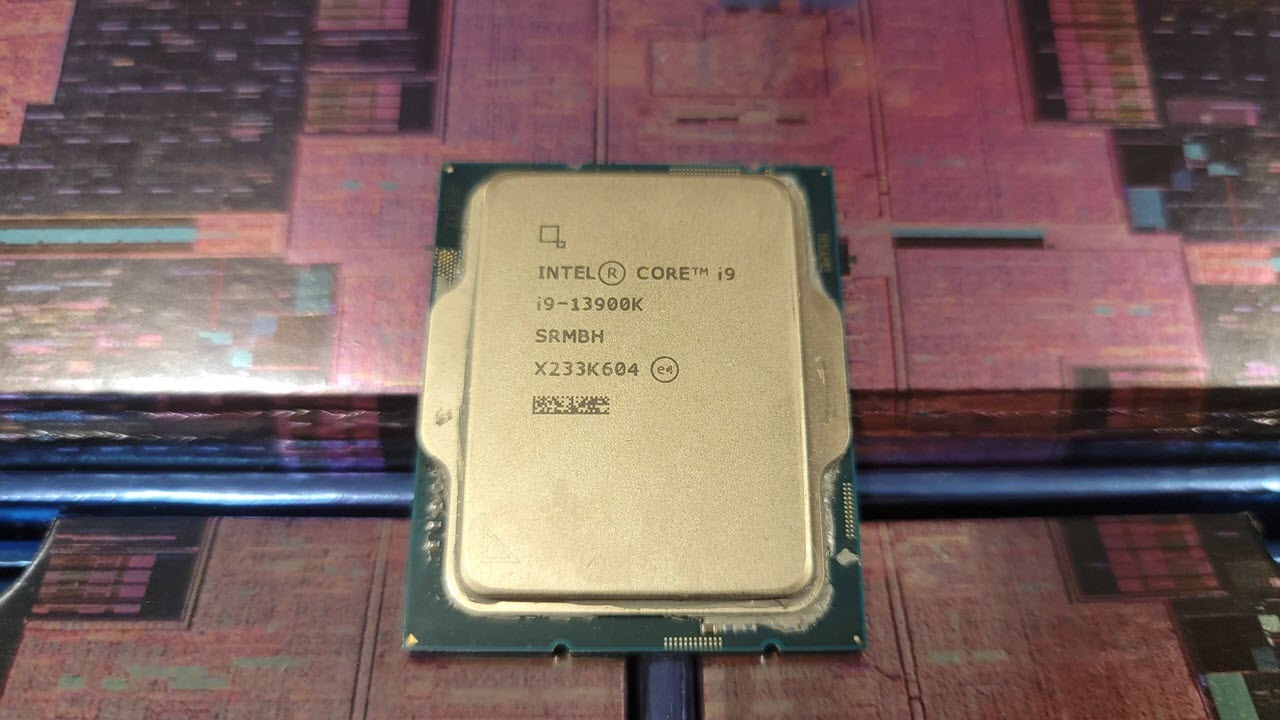Why you can trust Tom's Hardware
Productivity Benchmarks on Core i9-13900K and Core i5-13600K — The TLDR:

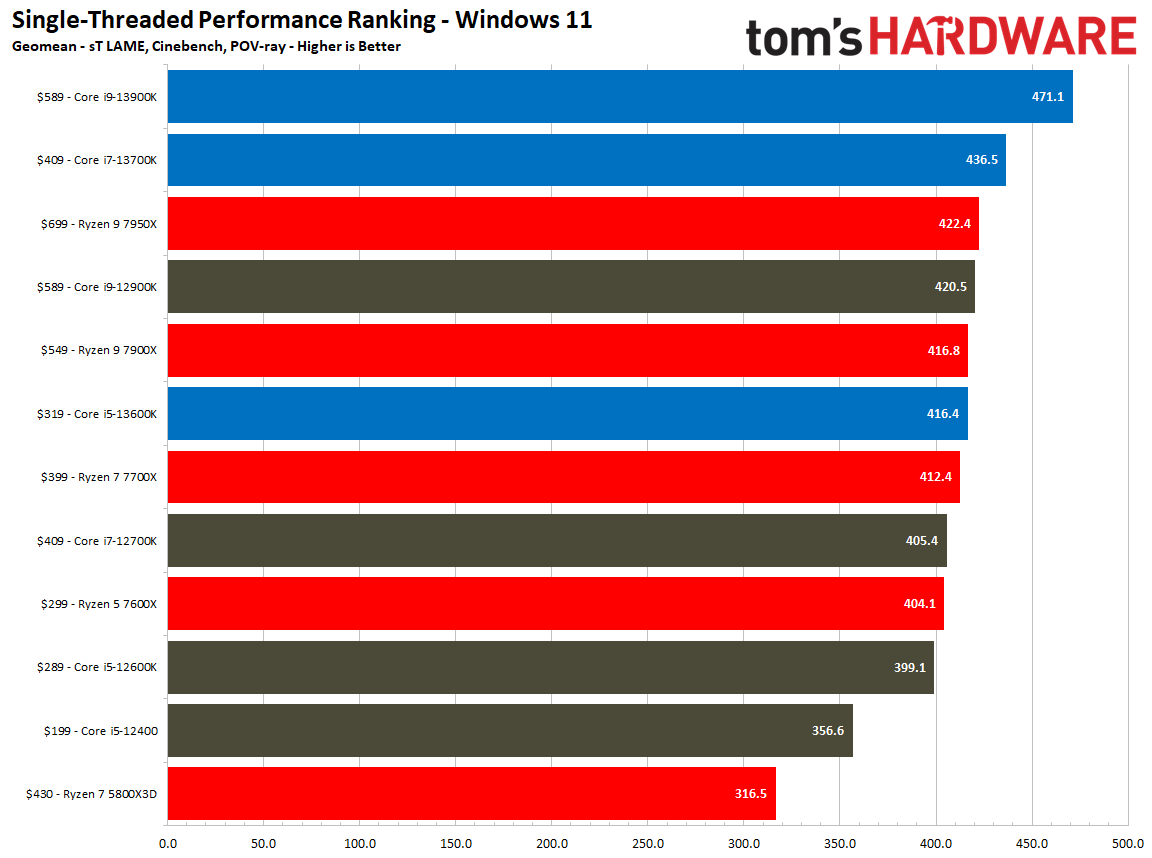
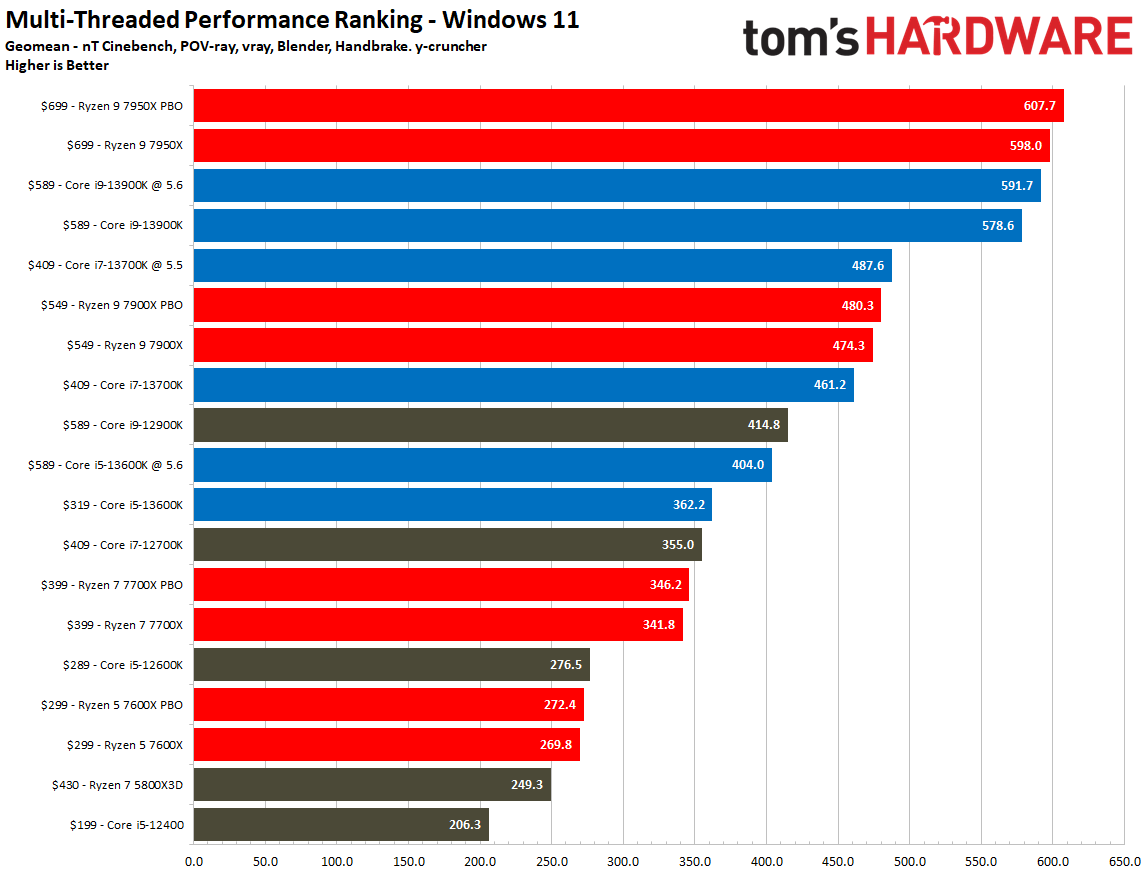

For simplicity's sake, the first two slides represent the test pool without overclocked configurations, while the latter slides add in the overclocked results. These cumulative measurements, comprised of the geometric mean of the most important application benchmarks below, give a good indication of overall performance and the trends you can expect from overclocking. As such, we won't include the overclocked results in the slides below.
For instance, we see huge gains in single-threaded work for the overclocked Core i5-13600K and Core i7-13700K, while the overclocked Core i9-13900K sees a slight reduction in most single-threaded work due to the 5.6 GHz all-core overclock. The overclocked Intel models all profit heavily from overclocking in threaded work, but we see very little improvement from overclocking the Ryzen chips.
At stock settings, the $699 Ryzen 9 7950X is roughly 3% faster than the $589 Core i9-13900K in multi-threaded workloads, barely holding on to its lead. Meanwhile, the Core i9-13900K is 22% faster in threaded work than the closer-priced $549 Ryzen 9 7900X.
We see larger advantages for Raptor Lake as we move down the stack. The $409 Core i7-13700K is 35% faster in threaded work than the similarly-priced $399 Ryzen 7 7700X, while the $319 Core i5-13600K takes a similar 34% lead over the $299 Ryzen 5 7600X.
Once again, we should take note of the explosive generational gains for Raptor Lake — we're looking at a 30% improvement for Core i5 and i7 in threaded work, and a whopping 40% improvement for the Core i9-13900K.
The Raptor Lake chips dominate in single-threaded work, beating the Ryzen comparables at every price point. The leads become far more pronounced after overclocking.
Here we also see the catch with the Zen 3-powered Ryzen 7 5800X3D — while this chip is incredibly potent in some games, compared to the newer processors, performance suffers in just about everything else.
| Tom's Hardware | Multi-Thread | Single-Thread |
| $699 — Ryzen 9 7950X | 100% | 89.66% |
| $589 — Core i9-13900K | 96.8% | 100% |
| $549 — Ryzen 9 7900X | 79.3% | 88.49% |
| $409 — Core i7-13700K | 77.1% | 92.7% |
| $319 — Core i5-13600K | 60.6% | 88.4% |
| $399 — Ryzen 7 7700X | 57.2% | 87.6% |
| $299 — Ryzen 5 7600X | 45.1% | 85.8% |
| $430 — Ryzen 7 5800X3D | 41.7% | 67.2% |
Rendering Benchmarks on Core i9-13900K and Core i5-13600K


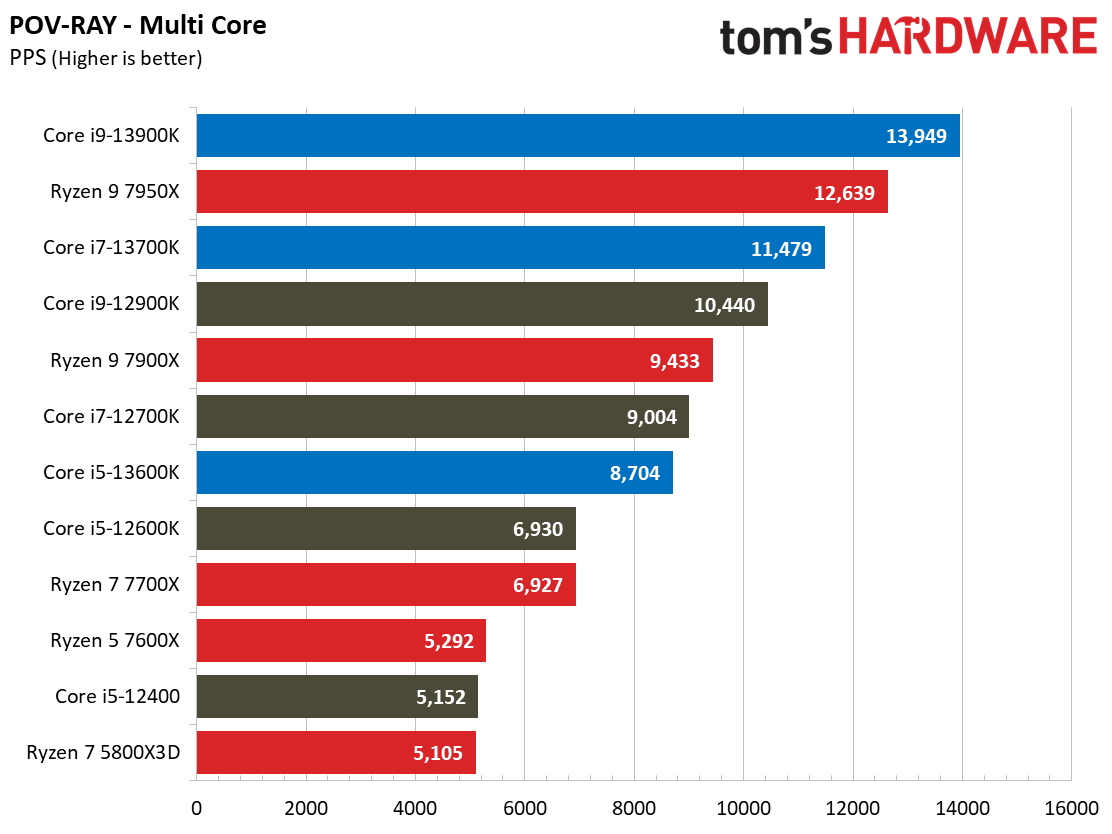



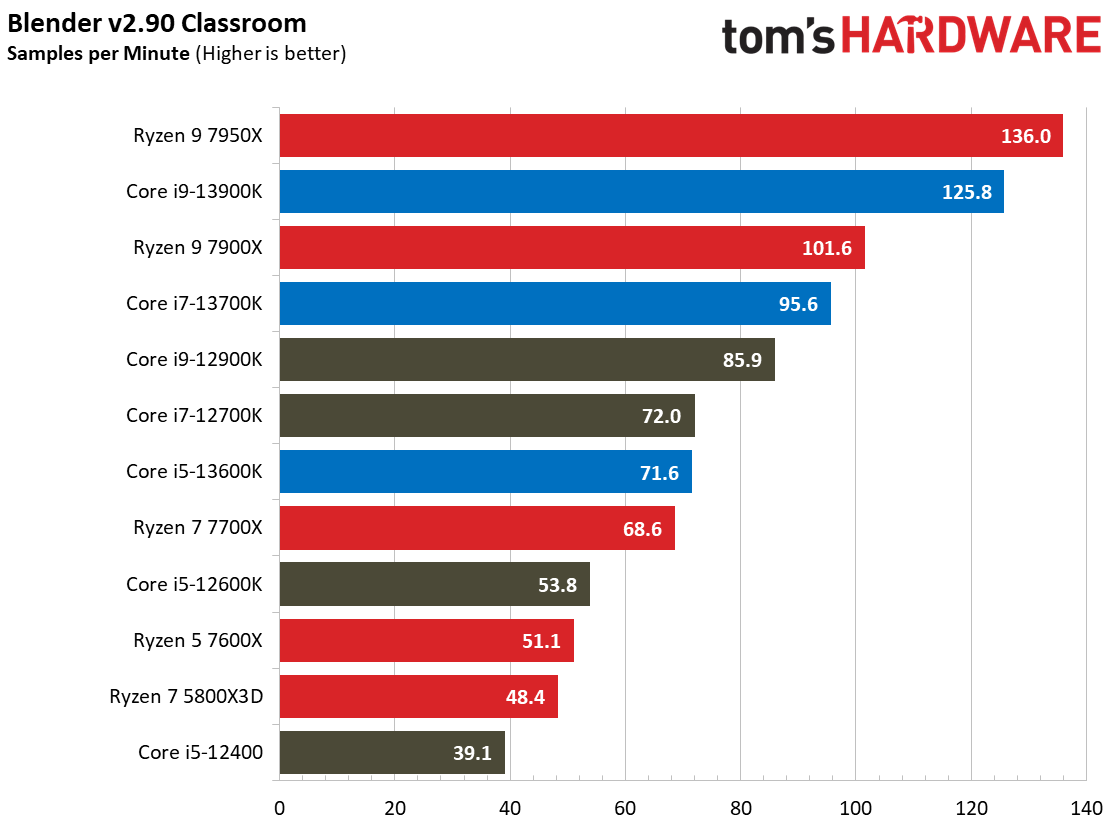

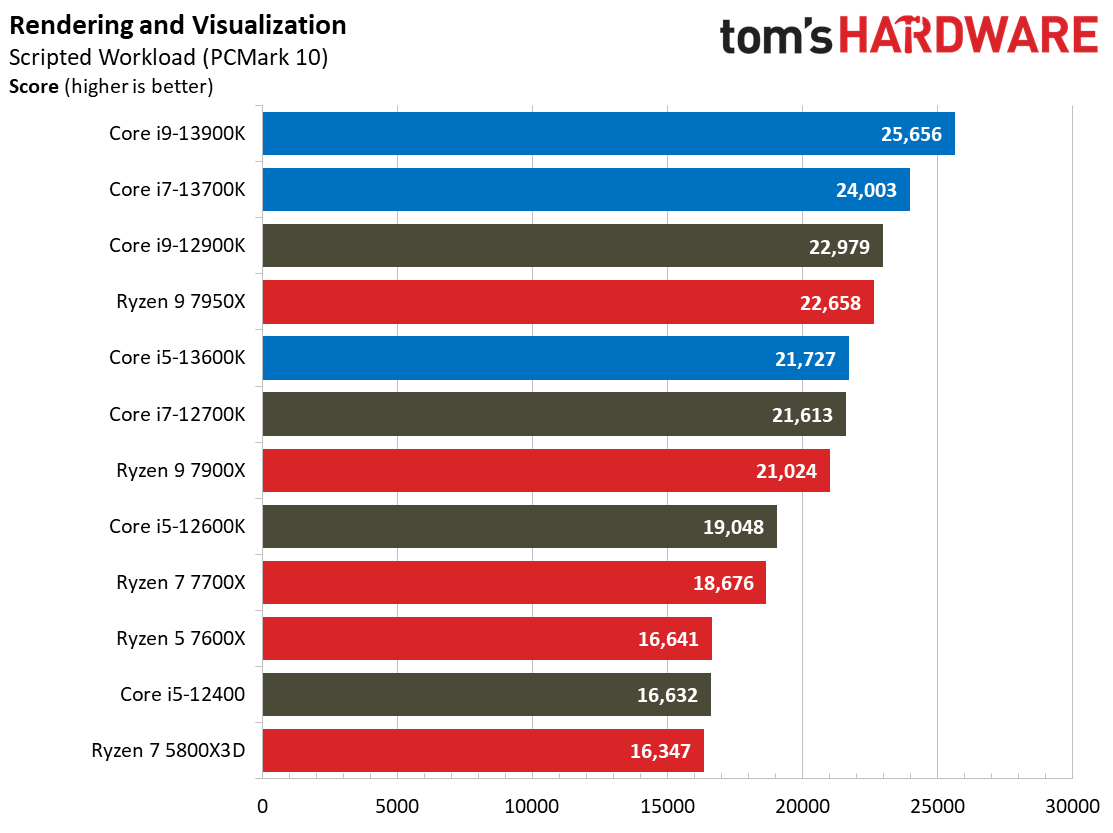

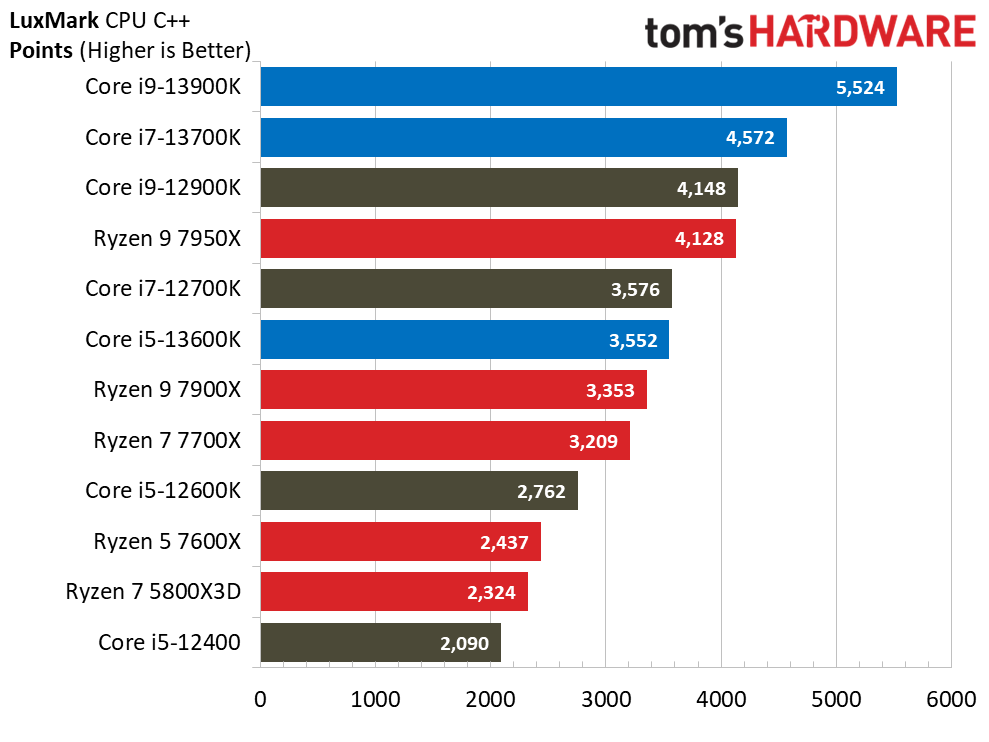

It was initially surprising to see Alder Lake’s hybrid architecture largely beat Ryzen in threaded workloads after AMD had dominated these types of benchmarks for years, but the Ryzen 9 7950X quashed that uprising, at least until Raptor Lake arrived.
The Core i9-13900K takes the lead in the threaded Cinebench and POV-Ray tests, but the Ryzen 9 7950X dominates the Blender and V-Ray benchmarks. Performance in threaded rendering engines ends up being a bit of a toss-up between Core i9 and Ryzen 9, but we do have to remember that the Ryzen 9 7950X costs $100 more than the 13900K. The Ryzen 9 7900X is actually closer at $50 less than the 13900K, but it trails in every workload. Additionally, the Core i9-13900K takes a convincing lead in all single-threaded rendering tasks over both Ryzen 9 chips.
Looking to the lower end of the product stacks, the Core i5-13600K's four extra e-cores and higher power limits pay dividends as it cruises to easy wins over the Ryzen 7 and 5 processors.
Again, pay attention to the gen-on-gen improvements over Alder Lake — they're impressive.
Encoding Benchmarks on Core i9-13900K and Core i5-13600K
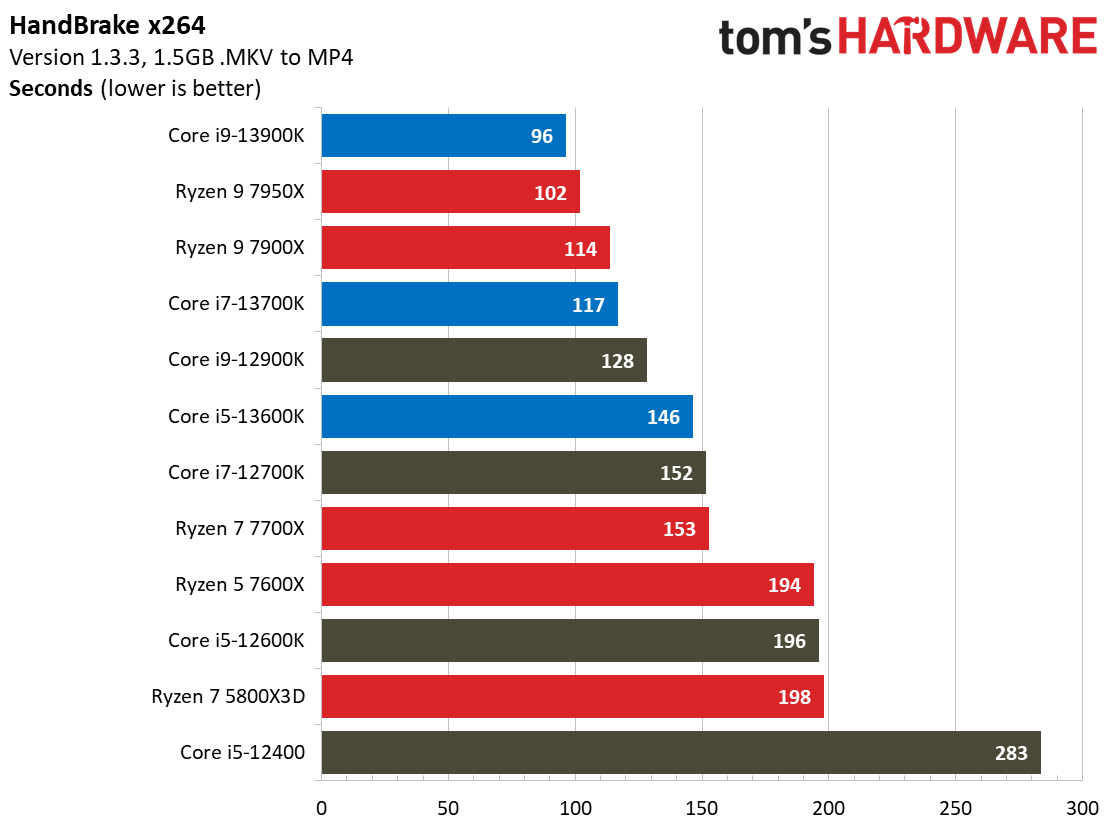

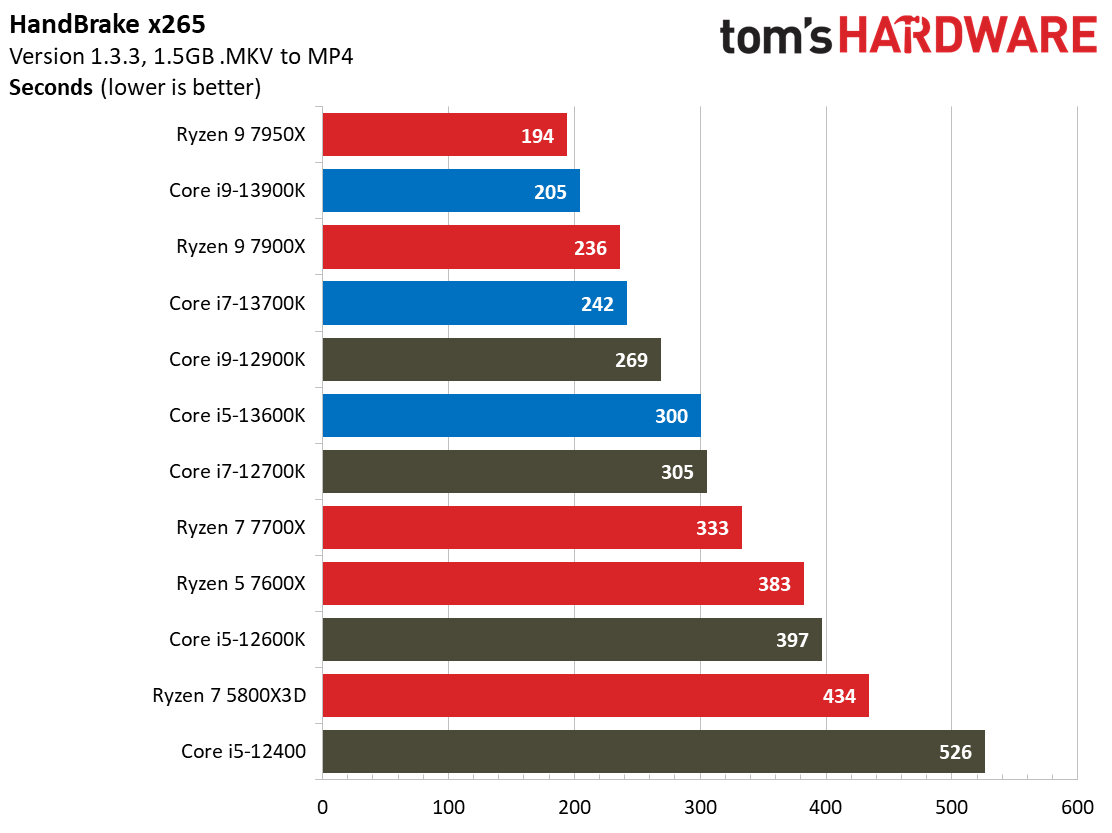

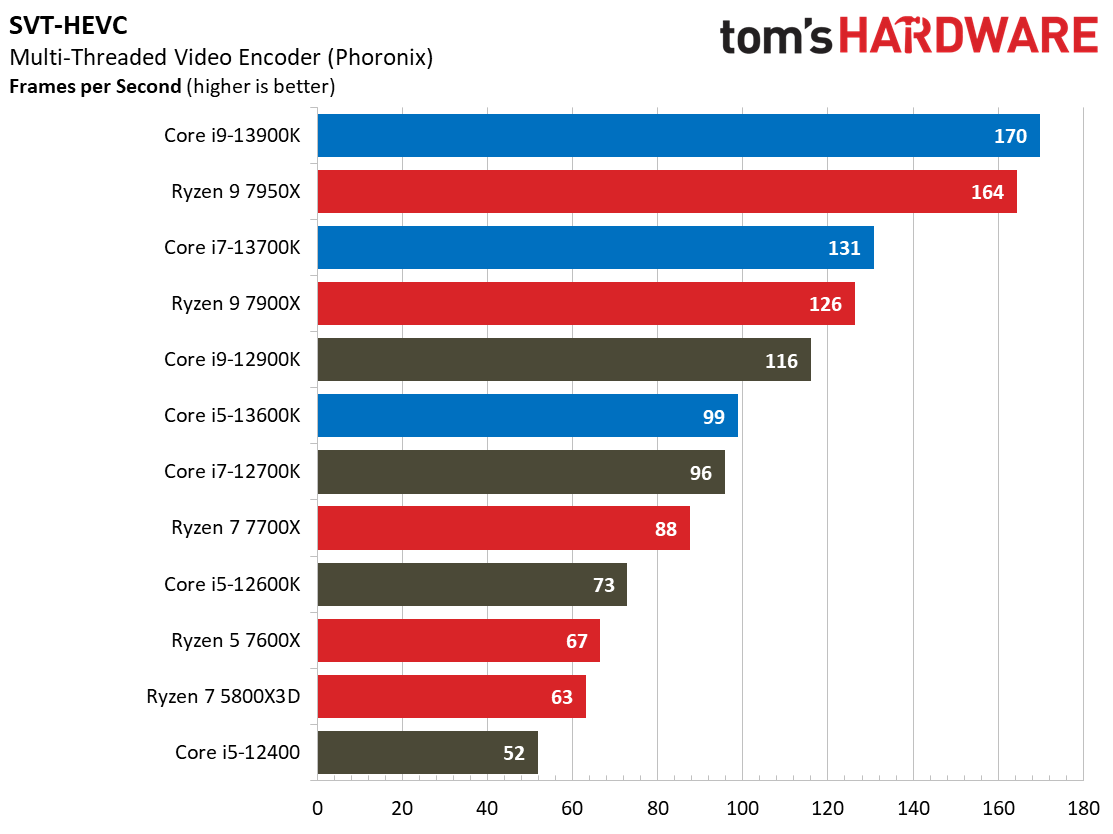
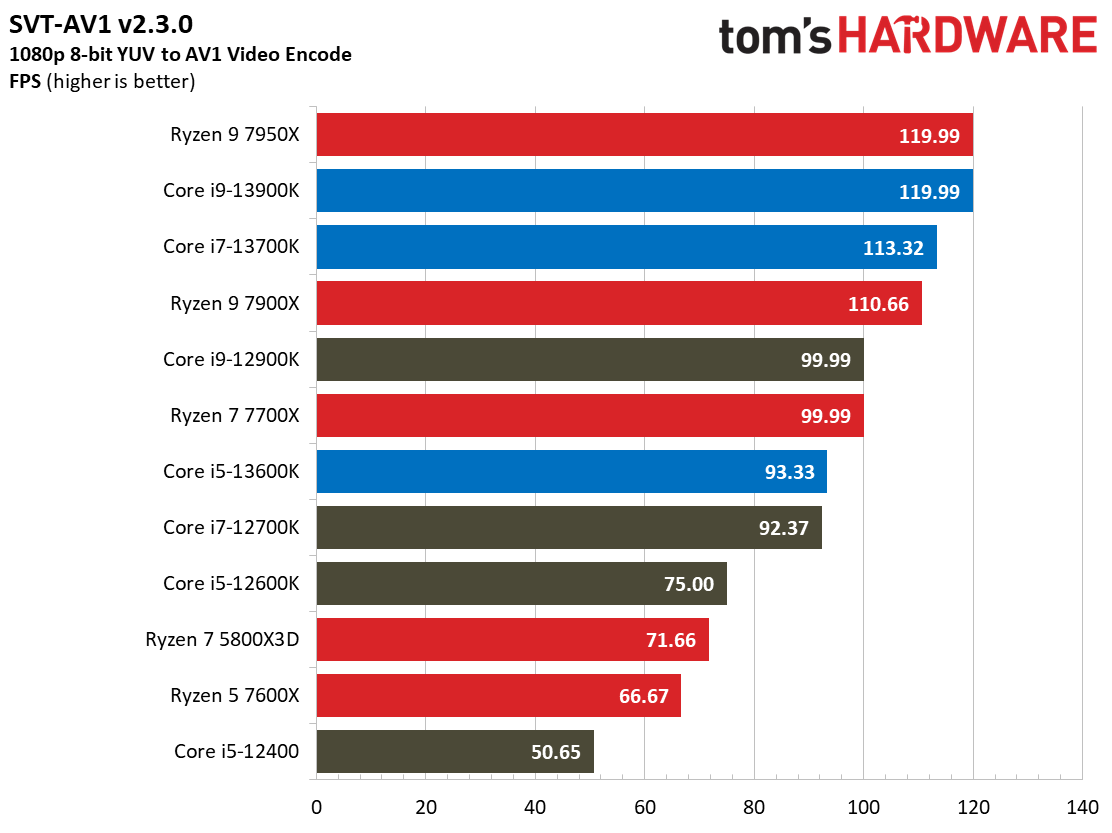
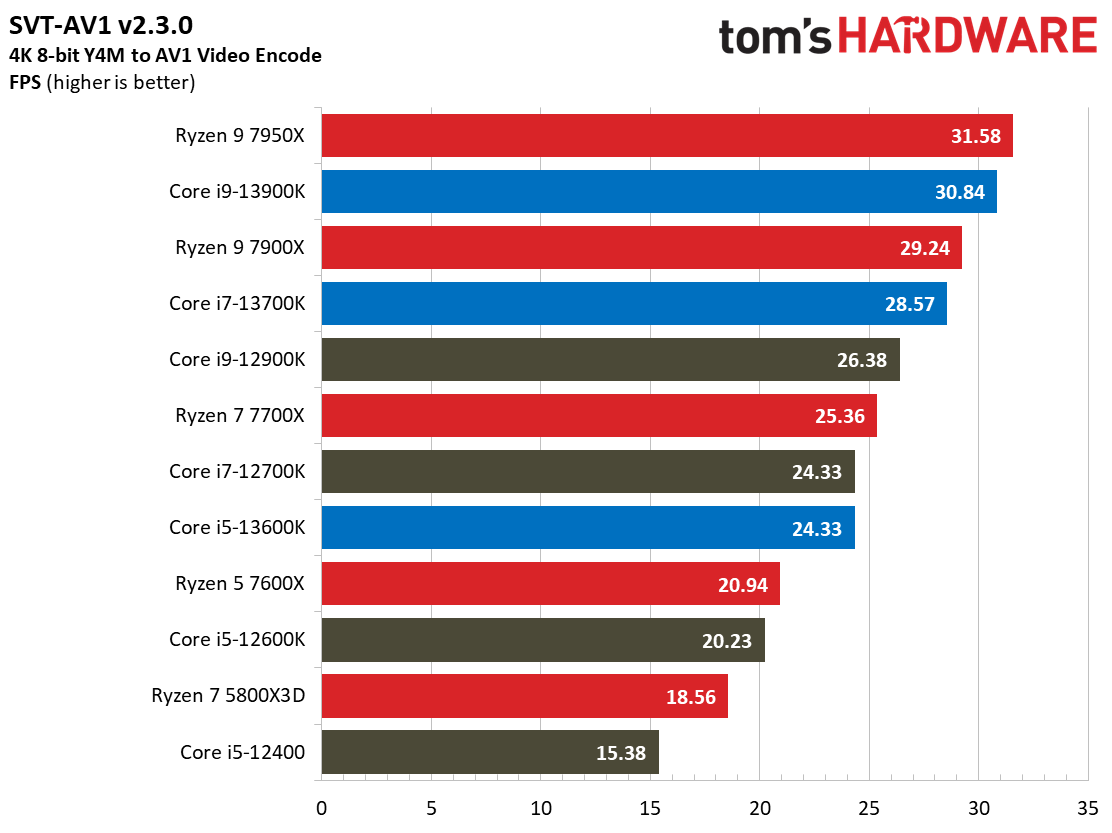
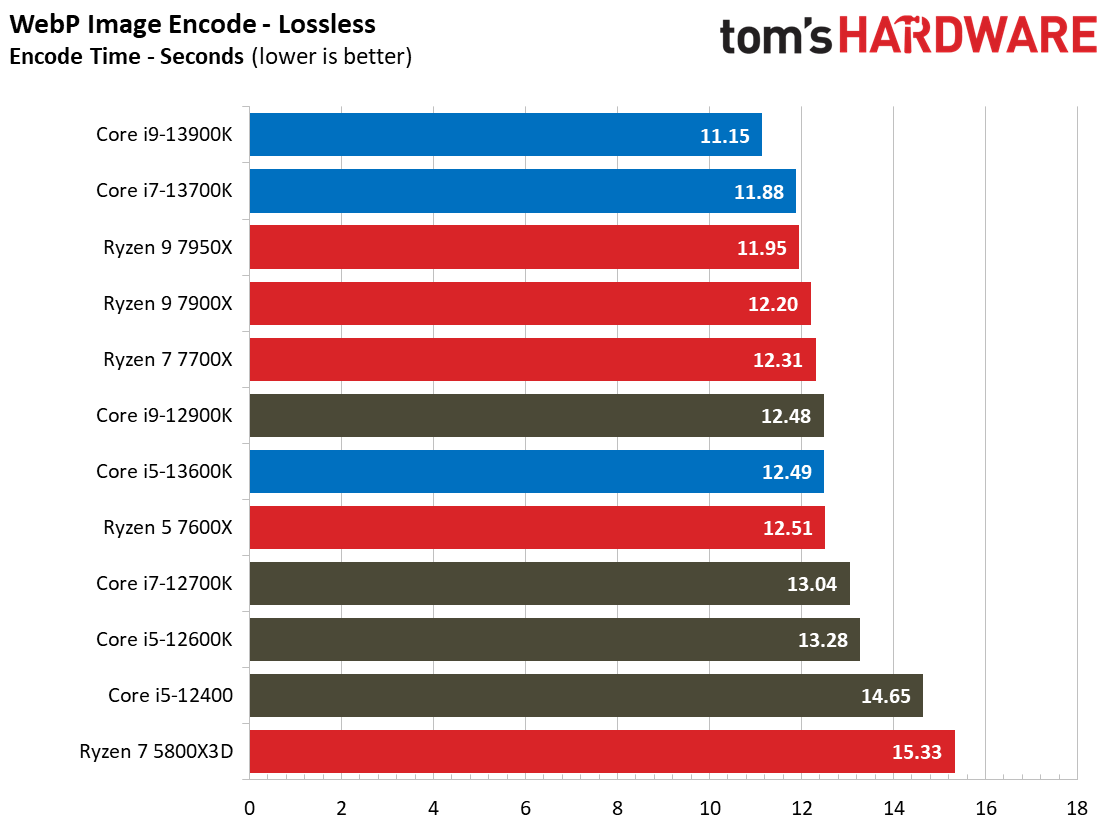
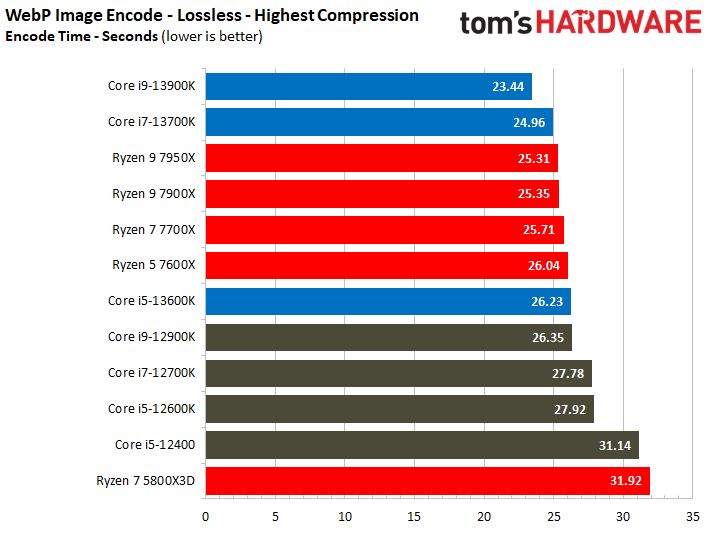
Most encoders tend to be either heavily threaded or almost exclusively single-threaded, and it takes an agile chip to master both disciplines.
The Core i9-13900K takes slim leads in the single-threaded LAME, WebP, and FLAC encoders, but the Ryzen 9 7950X is competitive across the board. The Core i5-13600K again leverages its extra cores and higher power limits to be exceptionally competitive given its price point.
As an interesting aside, the speed of these modern chips has broken our AV1 1080p benchmark; the chips are fast enough that they all plateau at the top speed seen in the chart (especially the overclocked configurations that aren't shown). We'll update with a suitable replacement in the future.
Adobe Premiere Pro, Photoshop and Lightroom on Core i9-13900K and Core i5-13600K

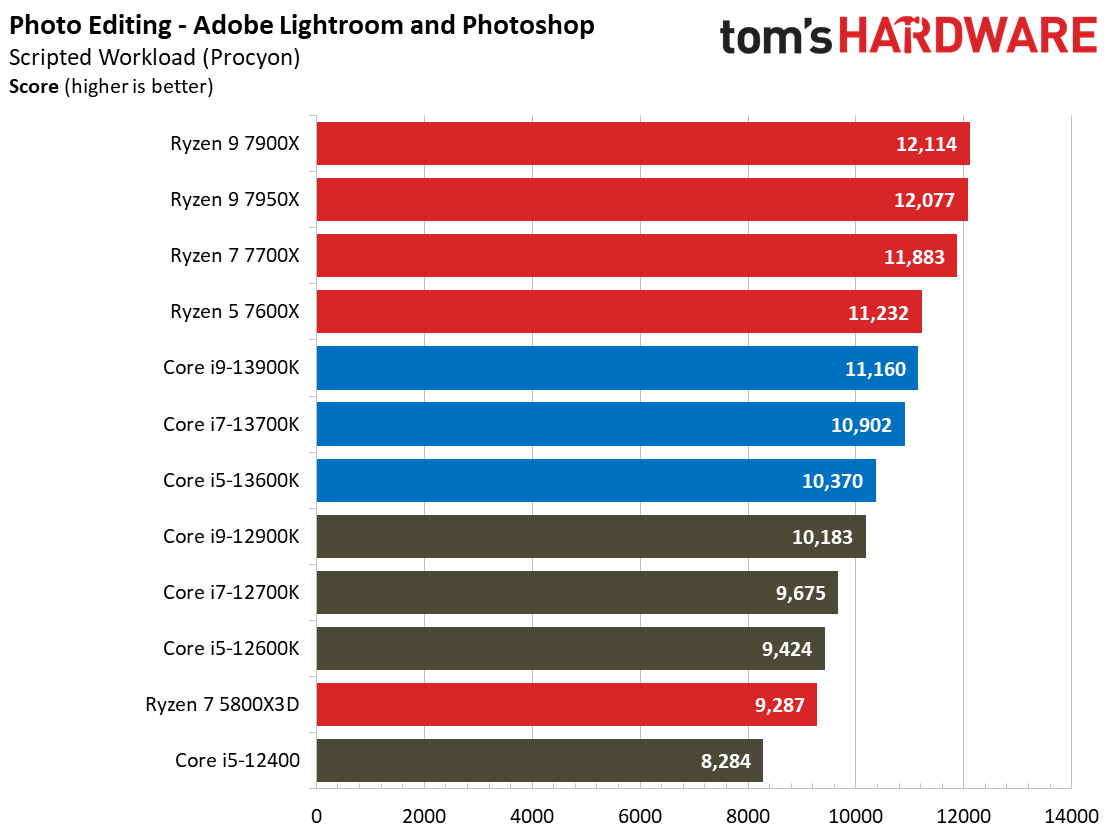
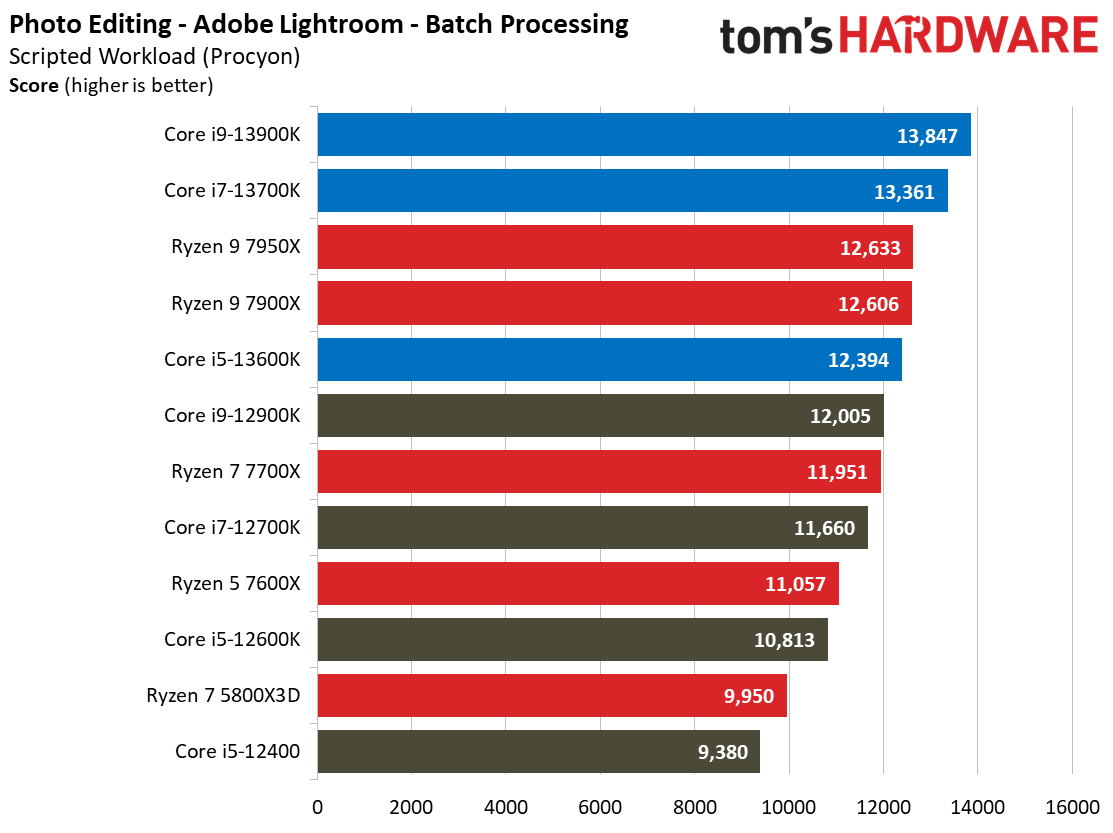
The UL Benchmarks Procyon benchmarks run complex Adobe Premiere Pro, Photoshop, and Lightroom workflows with the actual software, making for a great real-world test suite.
Aside from the Ryzen 7 5800X3D, the Ryzen 7000 processors take a clear lead in all but the batch processing sub-test.
Web Browsing, Office and Productivity on Core i9-13900K and Core i5-13600K
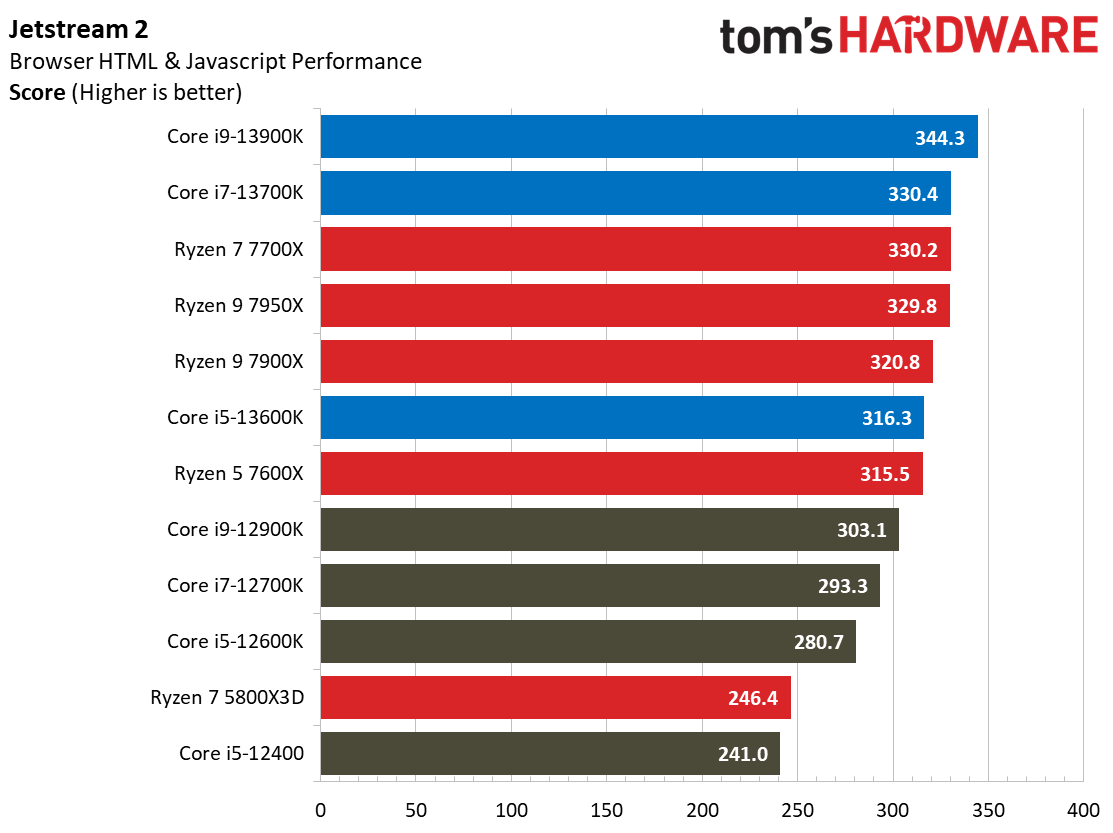

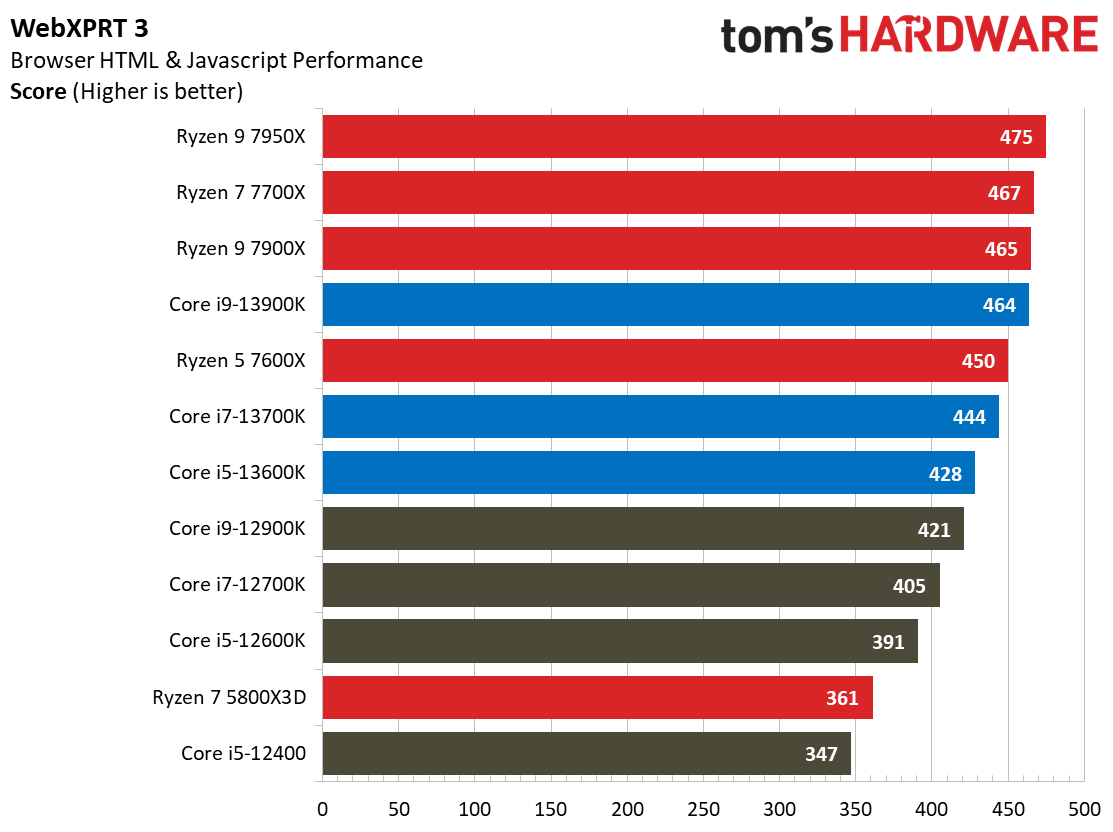

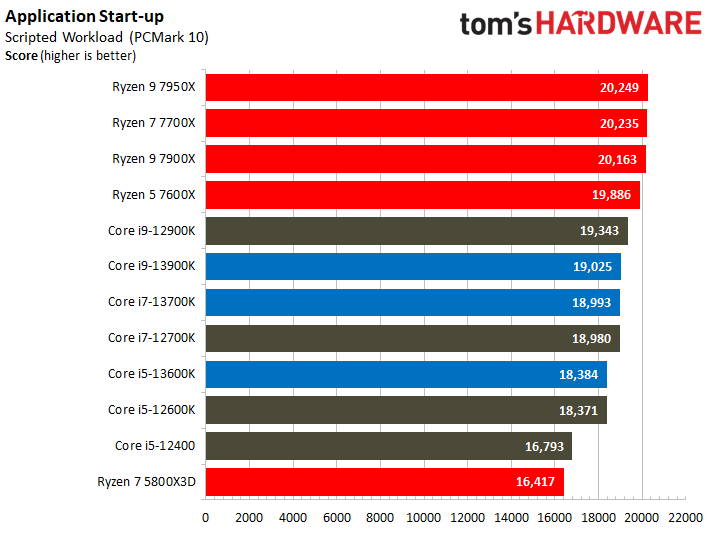
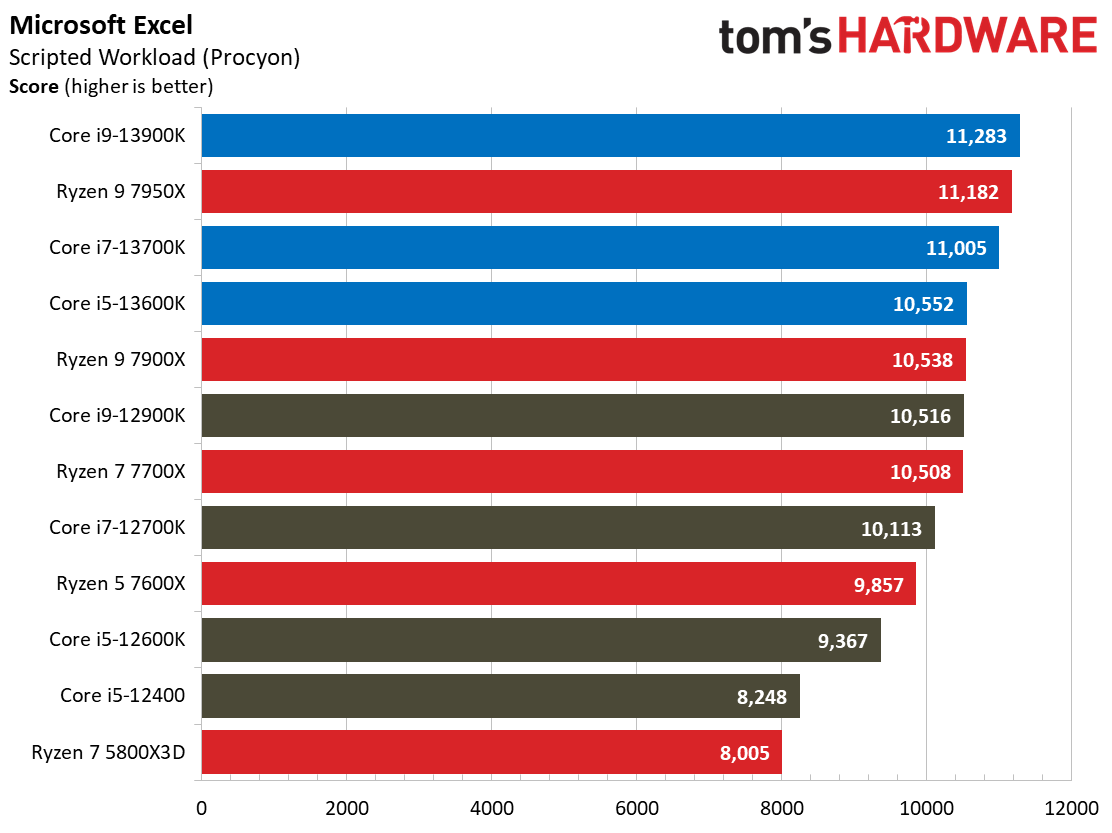
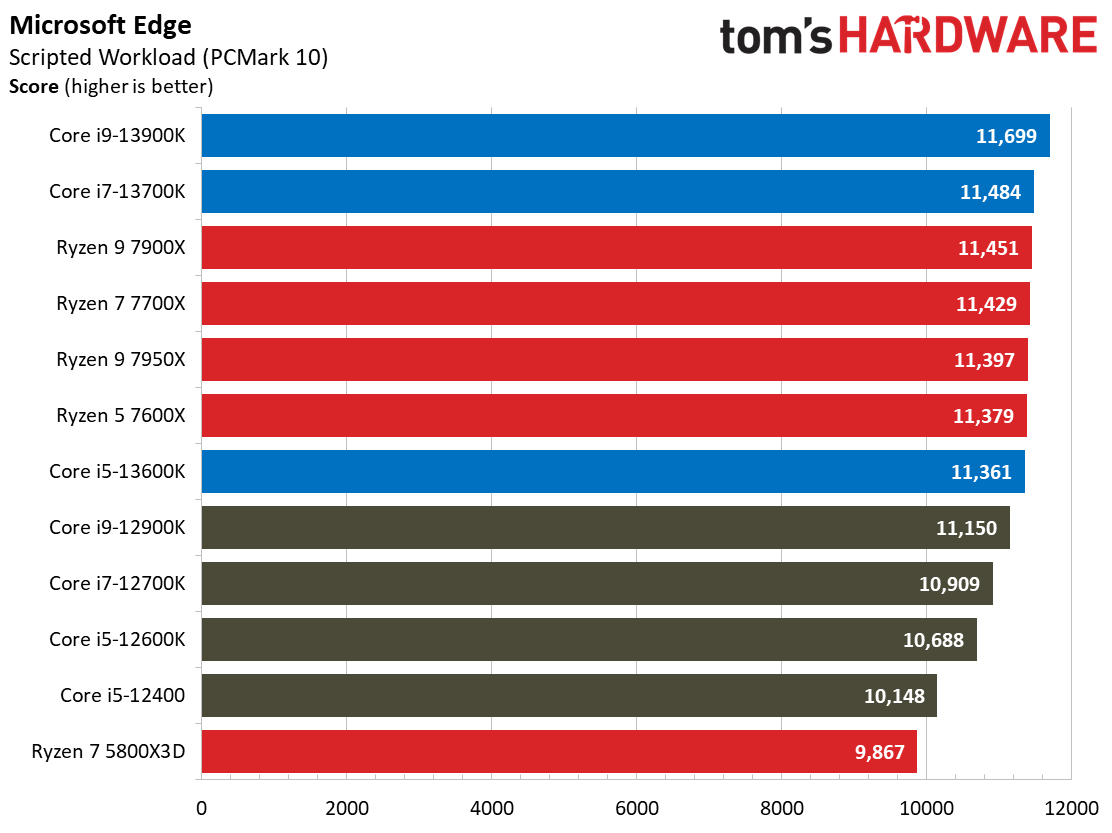
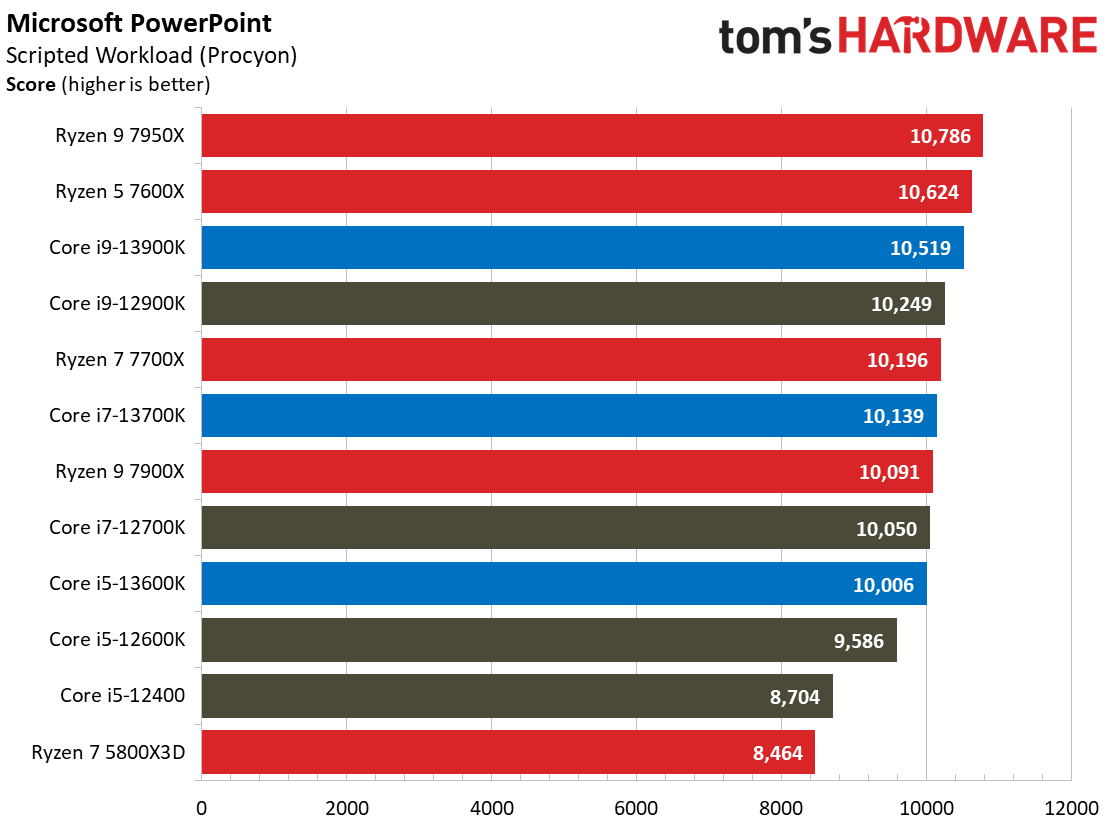
The ubiquitous web browser is one of the most frequently used applications. These latency-sensitive tests tend to be lightly threaded, so a fast response time is critical. The Application Start-up benchmark compares how long it takes to open various applications, thus serving as a great measure of system snappiness. Ryzen 7000 goes a long way to improving AMD’s performance here.
Compilation, Compression, AVX-512 Performance on Core i9-13900K and Core i5-13600K
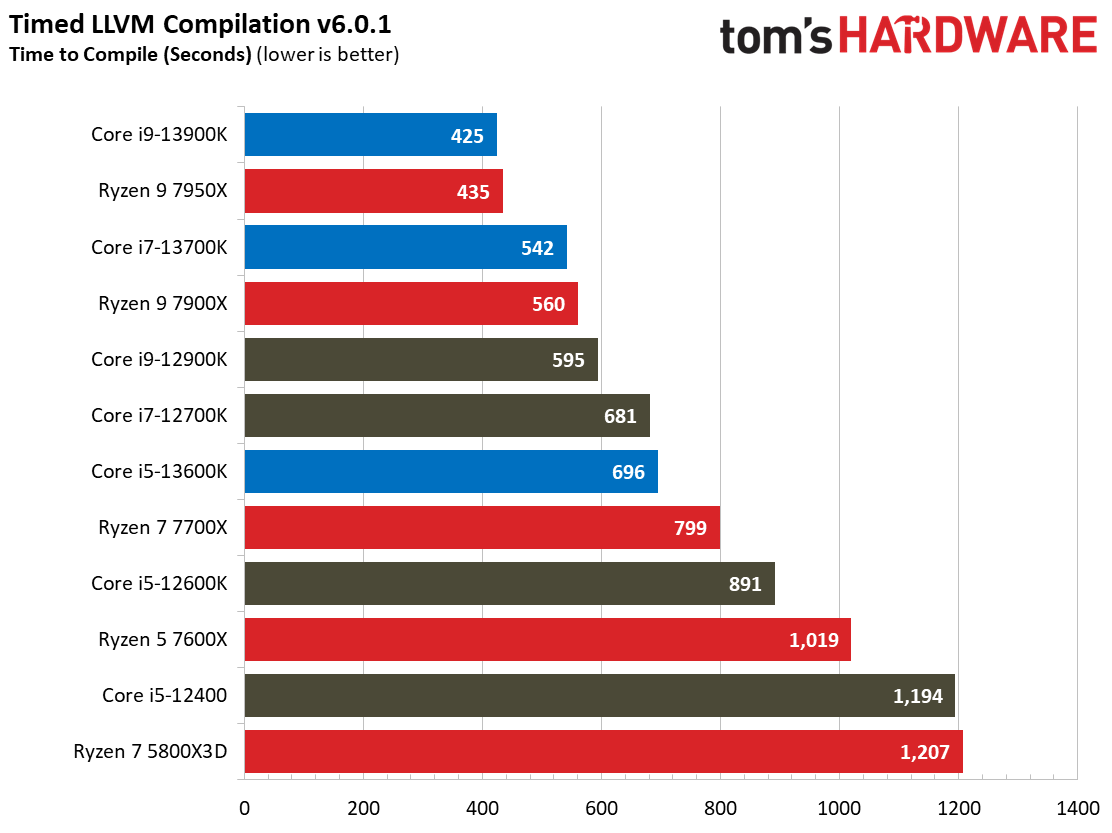
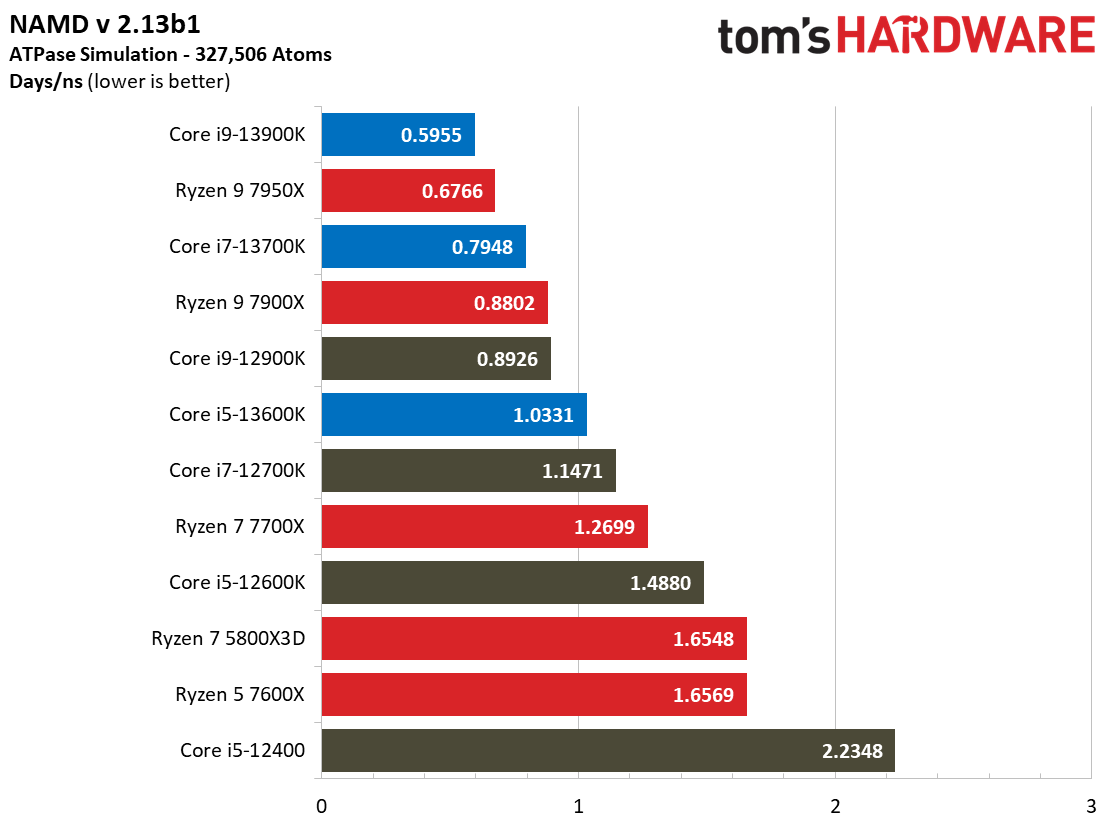


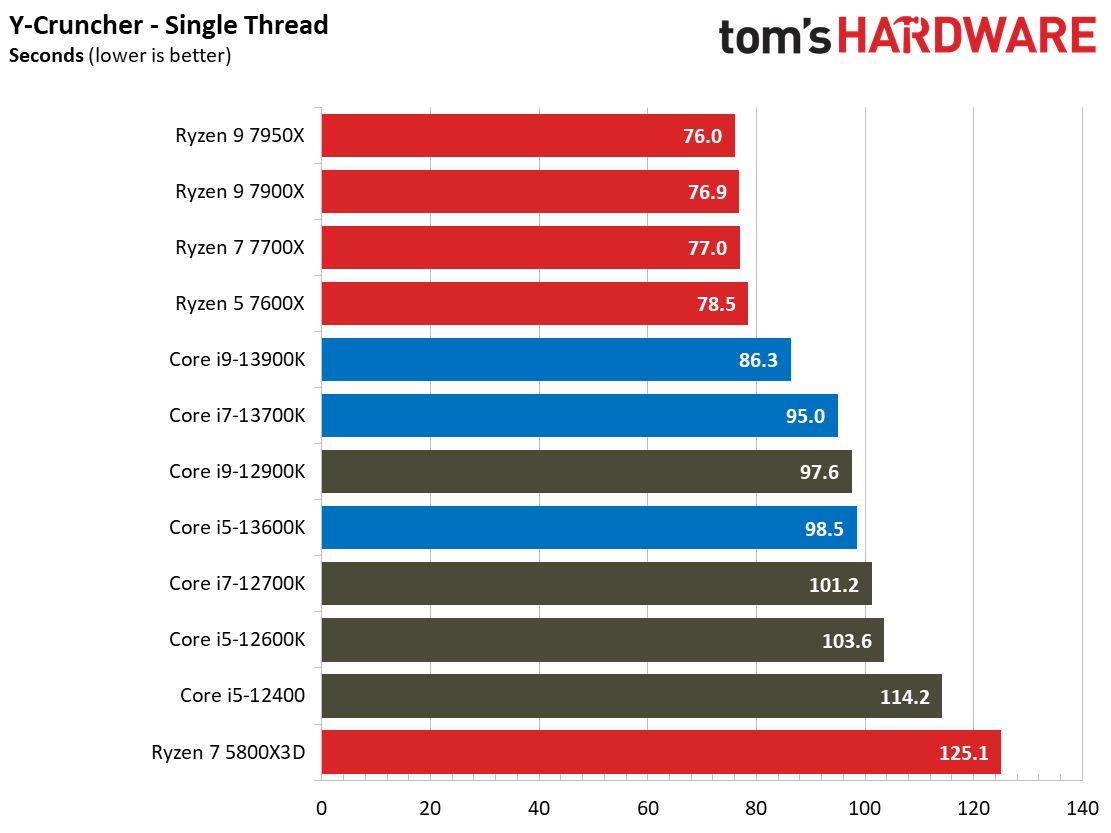


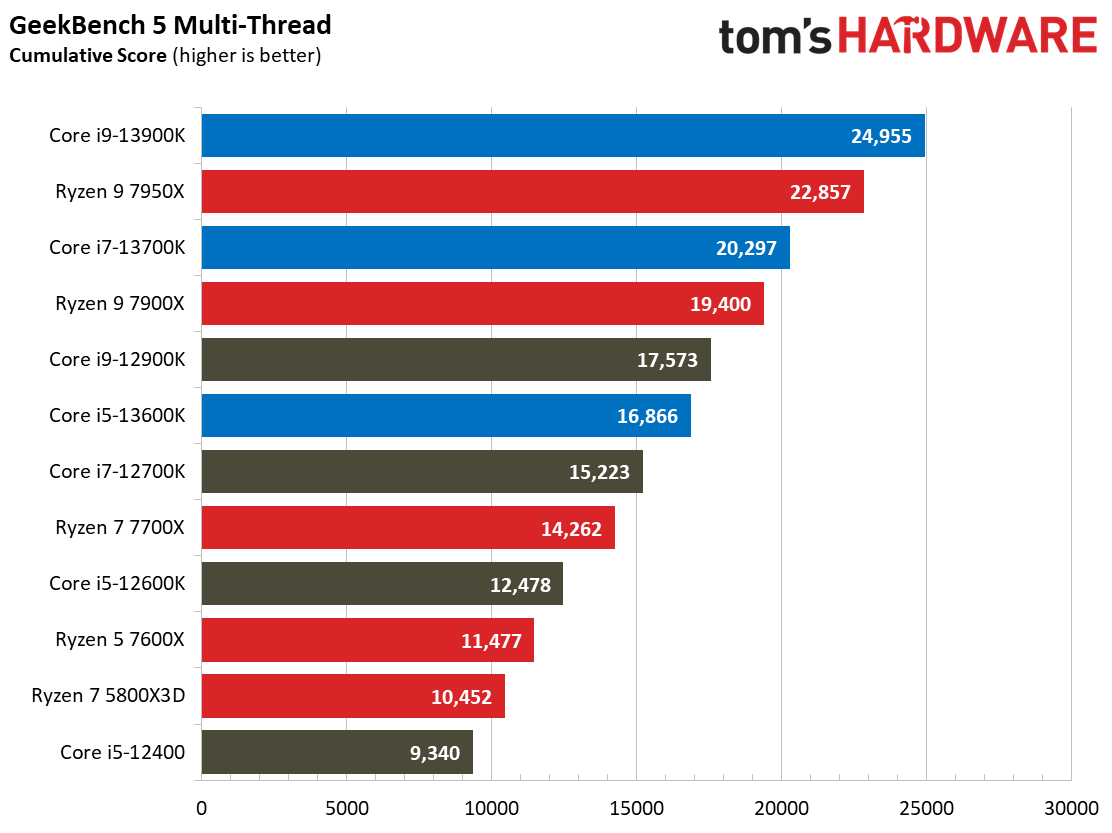

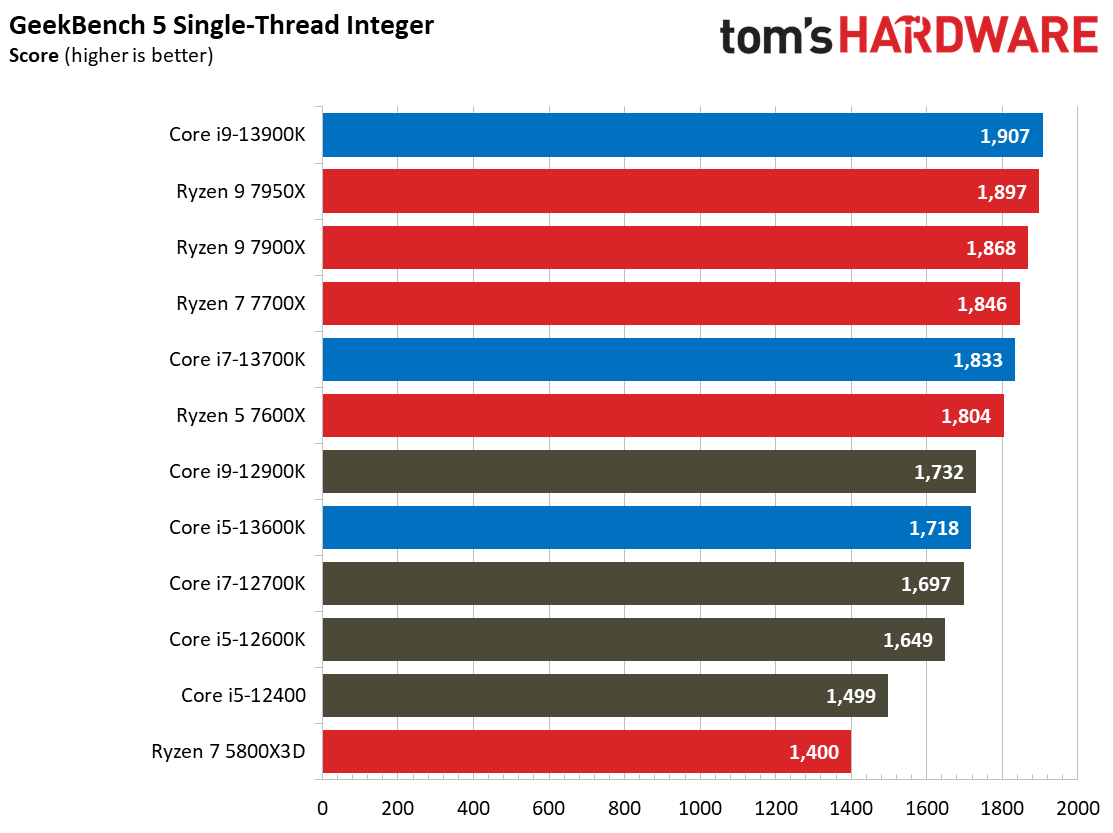
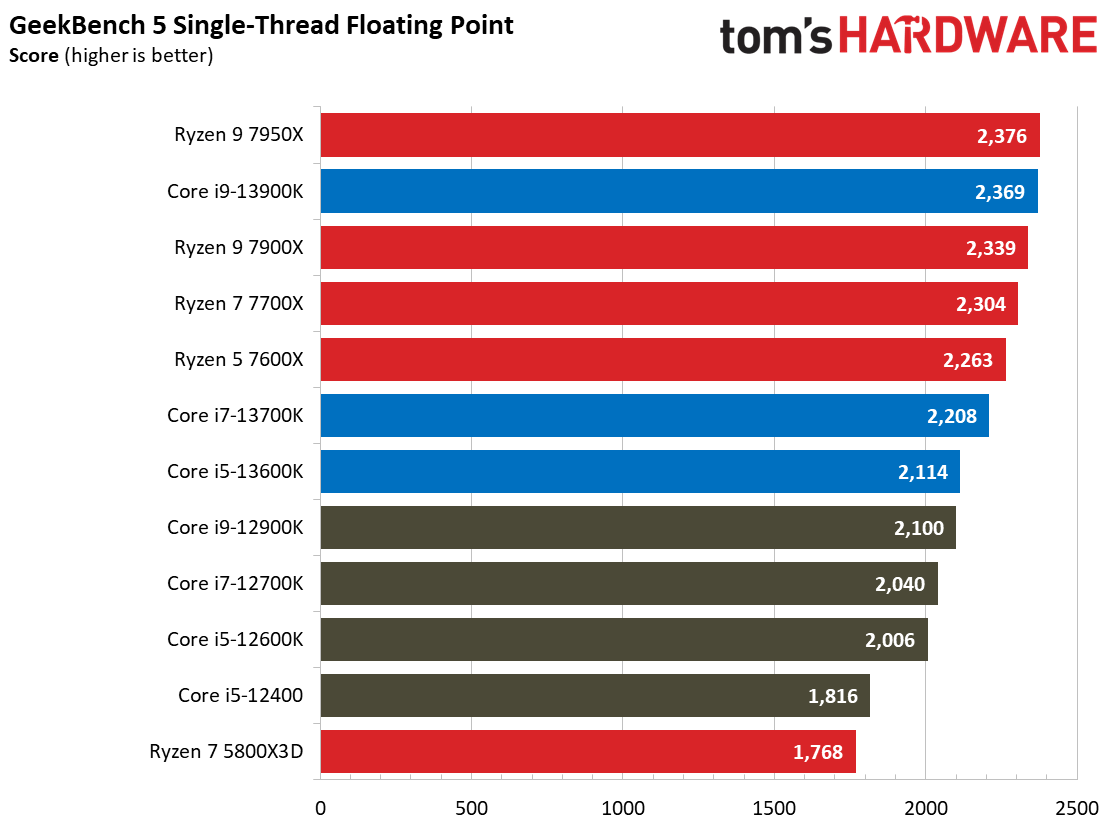
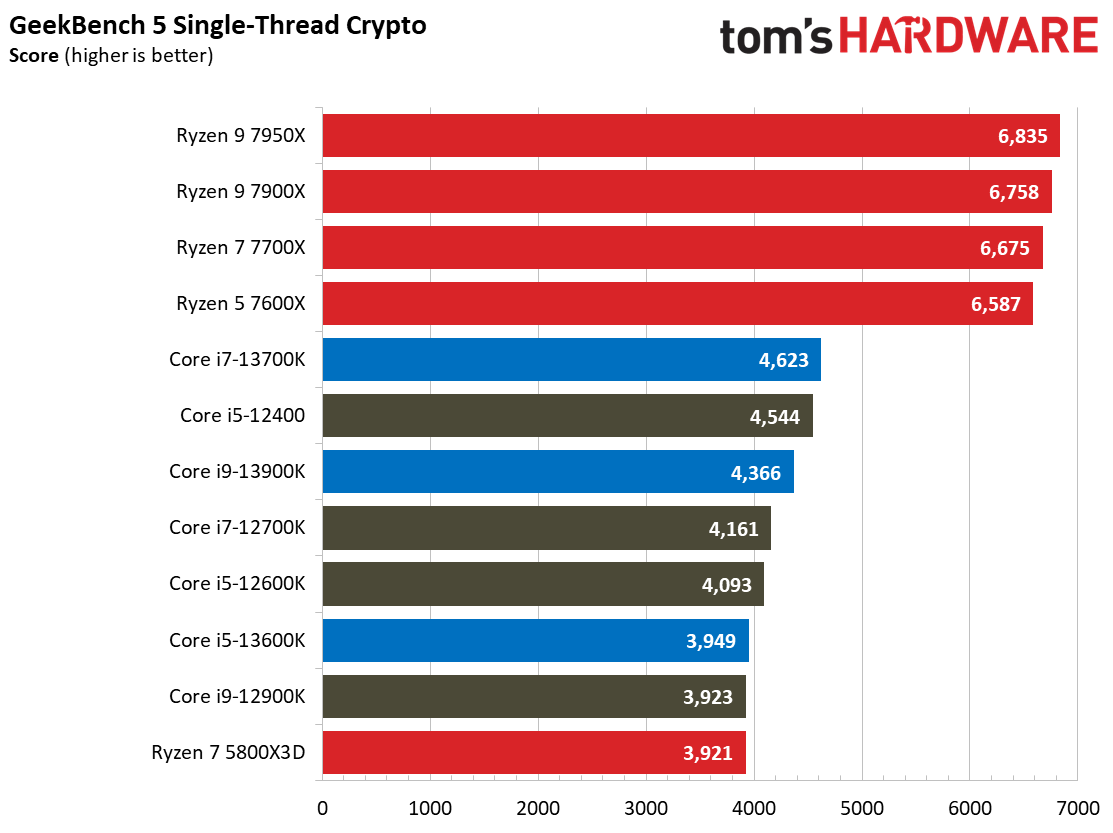
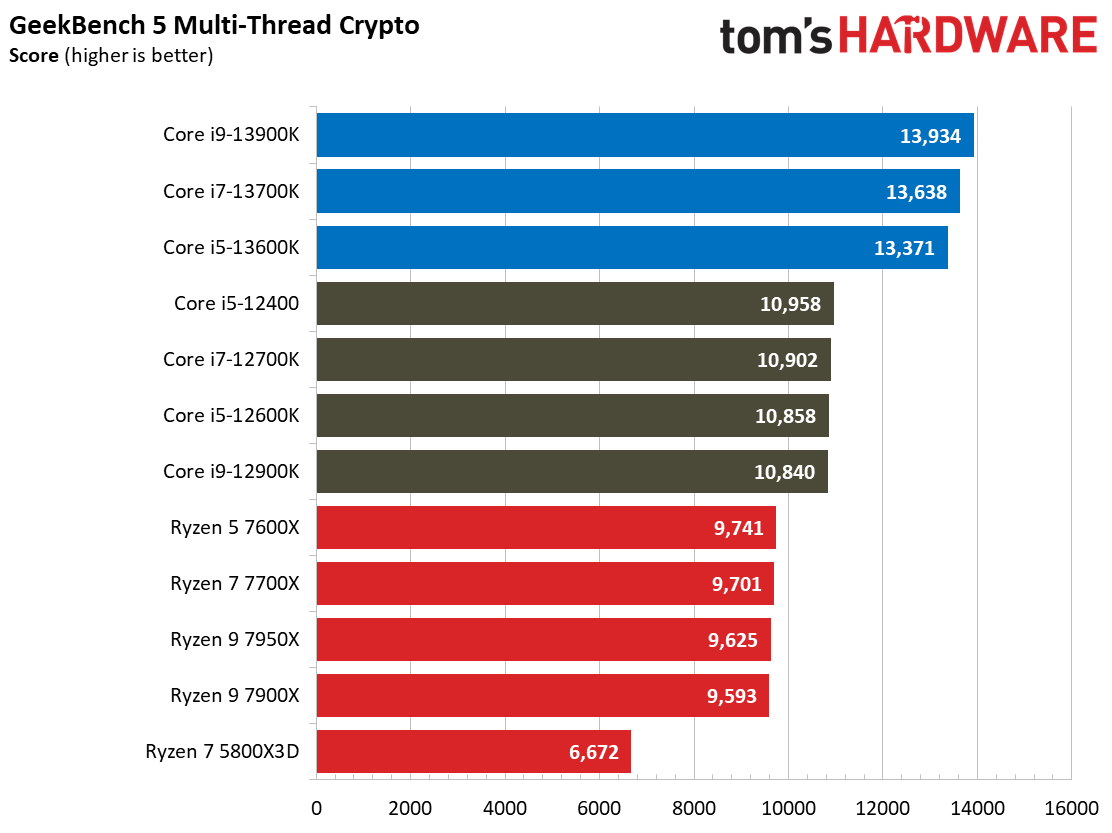

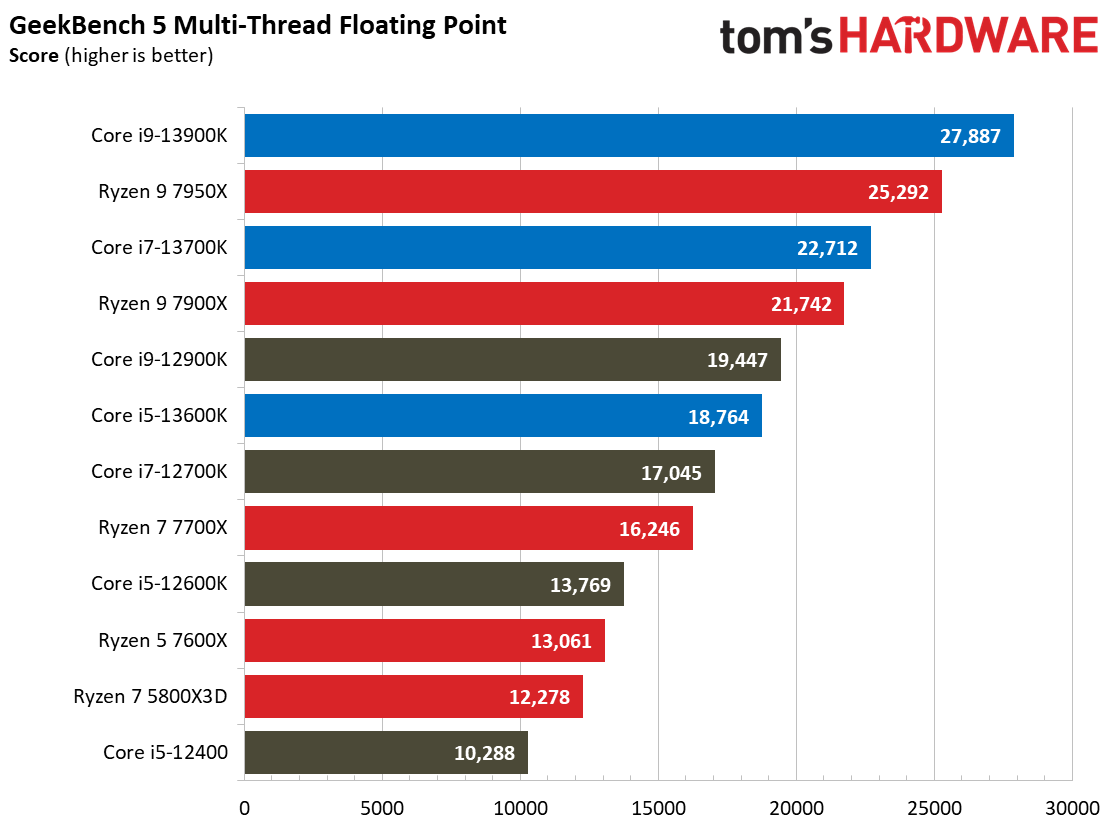
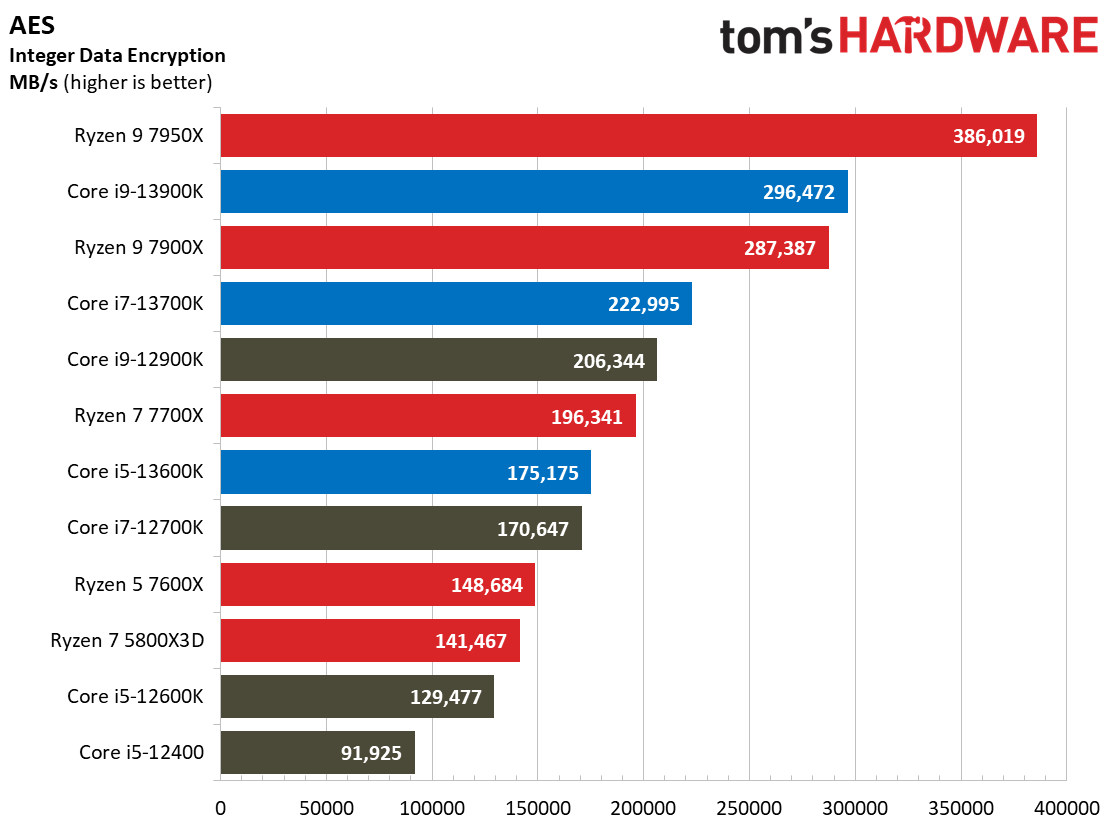
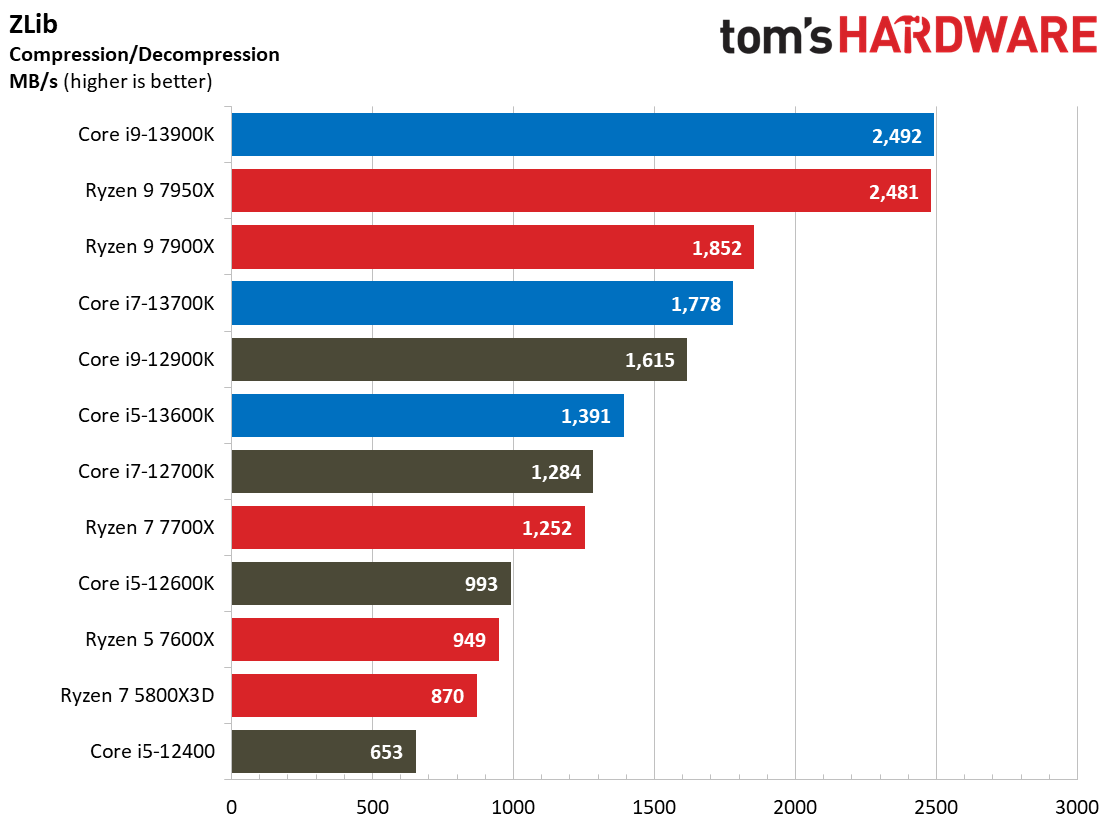

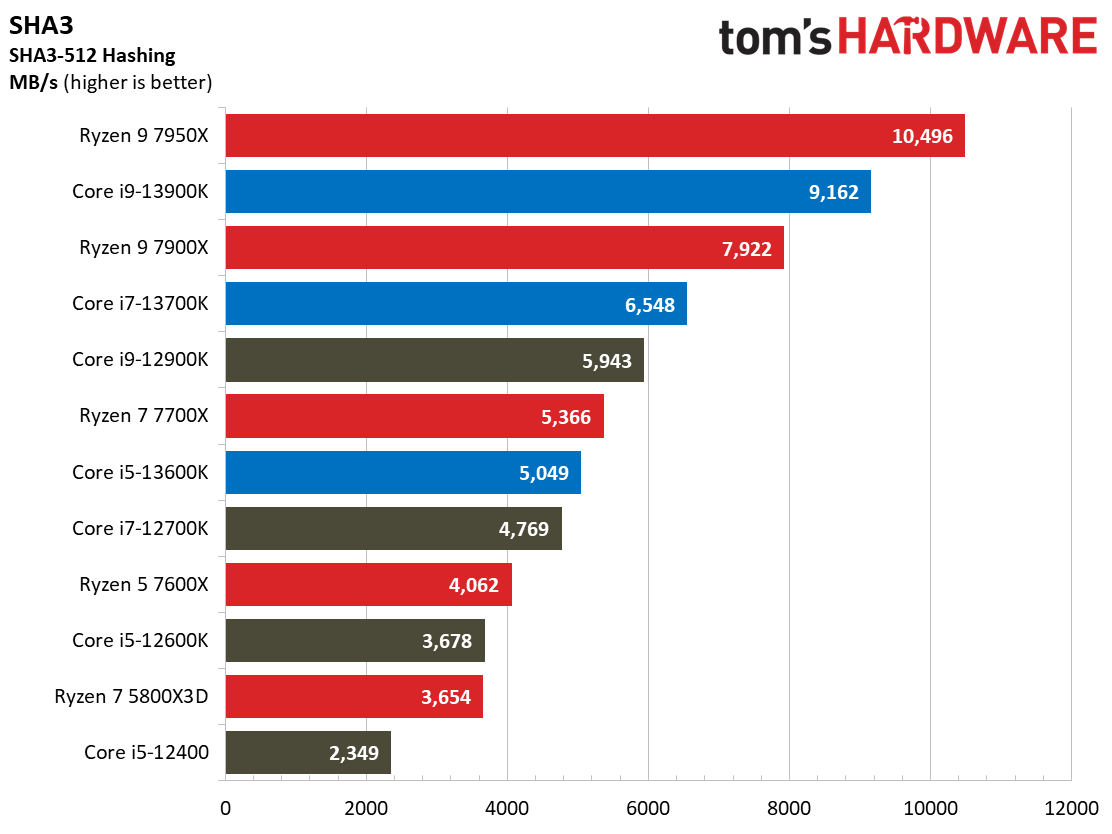
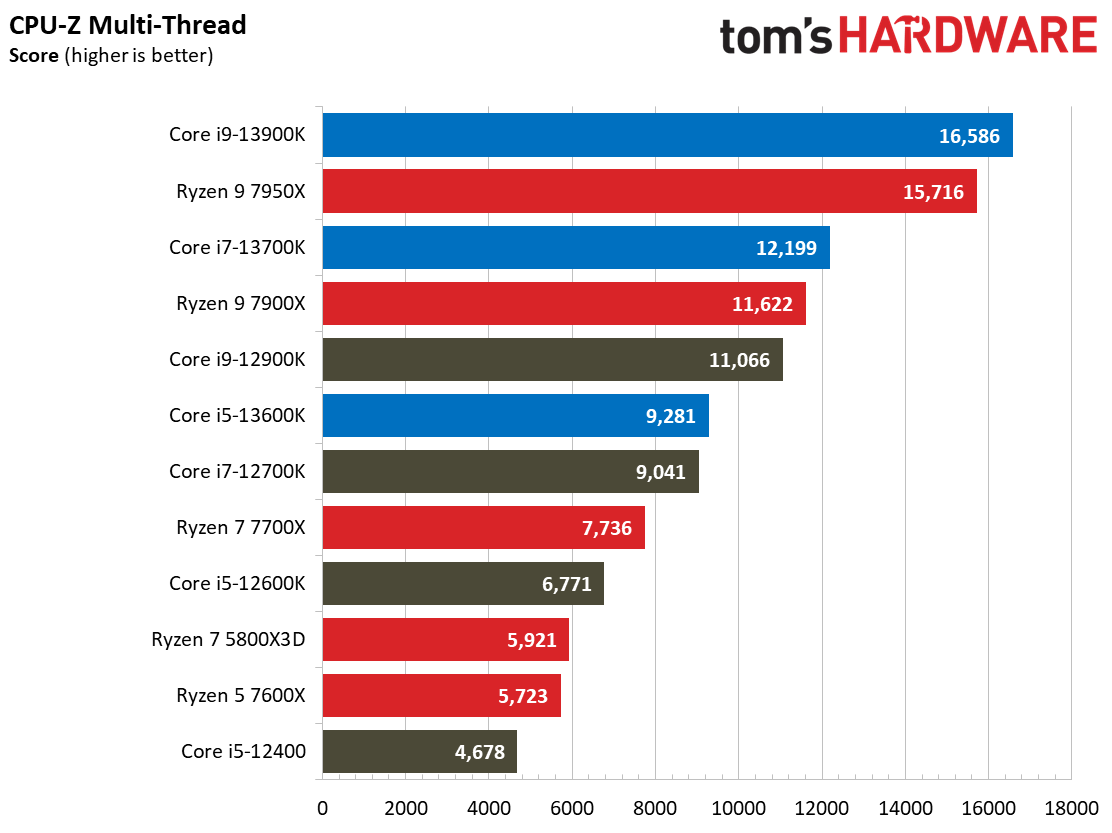
This selection of tests runs the gamut from the exceedingly branchy code in the LLVM compilation workload to the massively parallel molecular dynamics simulation code in NAMD to encryption and compression/decompression performance.
Y-cruncher computes Pi with the AVX instruction set, making for an exceedingly demanding benchmark. We employed the latest version of y-cruncher that has added support for Zen 4, and here we can see the benefits of AVX-512 become apparent in the single-threaded benchmark as the Ryzen 7000 chips all lead. Spreading the workload out among the cores in the threaded portion of the y-cruncher test yields a tie between the Core i9 and Ryzen 9 7950X.
We’re accustomed to Ryzen displaying bipolar performance in compression/decompression workloads, with decompression being a strength while compression suffered compared to other chips. The Zen 4 architecture makes big strides here, delivering incredible performance in both workloads with the Ryzen 9 7950X.
- MORE: AMD vs Intel
- MORE: Zen 4 Ryzen 7000 All We Know
- MORE: Raptor Lake All We Know
Get Tom's Hardware's best news and in-depth reviews, straight to your inbox.
Current page: Productivity Benchmarks on Core i9-13900K and Core i5-13600K
Prev Page Gaming Benchmarks Intel Core i9-13900K and Core i5-13600K Next Page The Raptors Are Out
Paul Alcorn is the Editor-in-Chief for Tom's Hardware US. He also writes news and reviews on CPUs, storage, and enterprise hardware.
-
Maebius Great review peeps.Reply
Curious, will you test Raptor Lake with DDR4?
Also, aren't new-gen motherboard prices (for both AMD and Intel), kinda uhm, on the expensive side, even for entry level? -
johnnyboy5520 The Raptor Lake 13900K and AMD 7950X are pretty much equivalent. As for gaming, the 7000 X3d chips will bury Raptor Lake. AMDs mistake was keeping the same core count on the lower end SKUs which allowed Intel an easy win in productivity. Gaming is pretty much game dependent. I don't think AMD will make that same mistake going forward. They've got the superior architecture.Reply -
Why_Me Reply
The B760 boards and locked Intel cpu's are due for release this January.Maebius said:Great review peeps.
Curious, will you test Raptor Lake with DDR4?
Also, aren't new-gen motherboard prices (for both AMD and Intel), kinda uhm, on the expensive side, even for entry level? -
TerryLaze Reply
It wasn't a mistake from AMD, it was all they could do.johnnyboy5520 said:The Raptor Lake 13900K and AMD 7950X are pretty much equivalent. As for gaming, the 7000 X3d chips will bury Raptor Lake. AMDs mistake was keeping the same core count on the lower end SKUs which allowed Intel an easy win in productivity. Gaming is pretty much game dependent. I don't think AMD will make that same mistake going forward. They've got the superior architecture.
There are only so many combinations of their CCX they can do.
To increase their core counts on the lower CPUs they would have to add an CCX to them and come up with a way to add a third CCX to their 7950x.
That would mean that they would lose a big chunk of their margins or increase their prices by that amount, both of these options would be very bad for AMD.
If TSMC comes up with a good node shrink then AMD can increase the amount of cores per CCX for the next round, but then again the amount of cores is already ridiculous and only appeals to a very small amount of people. -
PCWarrior Reply
Not sure how you can claim that AMD has the superior architecture. All the IPC tests show that Raptor Cove P-Cores are ahead of Zen 4 in IPC. Also Intel’s hybrid approach is proving highly effective when it comes to heavily multithreaded workloads. The only thing that AMD has an advantage over Intel is in efficiency but that is only thanks to TSMC N5 (which is a full node ahead of Intel 7) and not due to some AMD microarchitectural design advantage. If anything, the very fact that Intel offers the same or superior performance despite being a full node behind is due to having a better architecture. Much like Nvidia’s RTX 3060 (on Samsung 8nm, an equivalent to a TSMC '10nm') versus Intel’s A770 (on TSMC 6nm).johnnyboy5520 said:The Raptor Lake 13900K and AMD 7950X are pretty much equivalent. As for gaming, the 7000 X3d chips will bury Raptor Lake. AMDs mistake was keeping the same core count on the lower end SKUs which allowed Intel an easy win in productivity. Gaming is pretty much game dependent. I don't think AMD will make that same mistake going forward. They've got the superior architecture. -
The Historical Fidelity Intel artificially hiding L2 cache on the alderlake chips is pretty sus to me. Another reason I am done with Intel. Anti-consumer behavior all day.Reply -
The Historical Fidelity Reply
You are absolutely wrong about efficiency, Zen is a much more power and area efficient architecture. Except for when they decide to go for the highest clock speeds possible on the process node they manufacture on. TSMC’s node designs are notoriously voltage hungry on the top of their operating speeds. Bring down the top speed by 2-300 MHz and the zen 4 7950x sips power at a 105 watt TDP (AMD ECO mode) similar to zen 3 power.PCWarrior said:Not sure how you can claim that AMD has the superior architecture. All the IPC tests show that Raptor Cove P-Cores are ahead of Zen 4 in IPC. Also Intel’s hybrid approach is proving highly effective when it comes to heavily multithreaded workloads. The only thing that AMD has an advantage over Intel is in efficiency but that is only thanks to TSMC N5 (which is a full node ahead of Intel 7) and not due to some AMD microarchitectural design advantage. If anything, the very fact that Intel offers the same or superior performance despite being a full node behind is due to having a better architecture. Much like Nvidia’s RTX 3060 (on Samsung 8nm, an equivalent to a TSMC '10nm') versus Intel’s A770 (on TSMC 6nm). -
TerryLaze Reply
On average the 7950x is about 3% faster in multi, (loses hard on single) and uses 20W less power.The Historical Fidelity said:You are absolutely wrong about efficiency, Zen is a much more power and area efficient architecture. Except for when they decide to go for the highest clock speeds possible on the process node they manufacture on. TSMC’s node designs are notoriously voltage hungry on the top of their operating speeds. Bring down the top speed by 2-300 MHz and the zen 4 7950x sips power at a 105 watt TDP (AMD ECO mode) similar to zen 3 power.
It is more efficient, but much more is hugely hyperbolic, it's so little most people won't even bother to call it a difference.
And you can reduce power draw on the 13900k as well and you only lose performance in a very few applications.You know which ones because all the "trusted reviewers" use exclusively those apps and nothing more.
https://www.pcwelt.de/article/1357334/core-i9-13900k-core-i5-13600k-im-test.html -
The Historical Fidelity ReplyTerryLaze said:On average the 7950x is about 3% faster in multi, (loses hard on single) and uses 20W less power.
It is more efficient, but much more is hugely hyperbolic, it's so little most people won't even bother to call it a difference.
And you can reduce power draw on the 13900k as well and you only lose performance in a very few applications.You know which ones because all the "trusted reviewers" use exclusively those apps and nothing more.
https://www.pcwelt.de/article/1357334/core-i9-13900k-core-i5-13600k-im-test.html
That is actually still very high power usage even with MCE off and PL1/2 adherence.
In a thorough review (reference below) of power efficiency we see:
the 7950x at 142 watts beating the 13900k at 142 watts by 13.4% on the combined productivity benching suite graph,
the 7950x at 88 watts beating the 13900k at 88 watts by 14.3% on the combined productivity benching suite graph,
and the 7950x at 65 watts beating the 13900k at 65 watts by 11.7% on the combined productivity benching suite graph.
That’s an average 13.13% better performance efficiency at the same power levels for the 7950x compared to 13900k. That’s a big difference to say the least.
https://tekdeeps.com/energy-efficiency-ryzen-9-7950x-40-over-core-i9-13900k-even-after-tdp-limitation/
